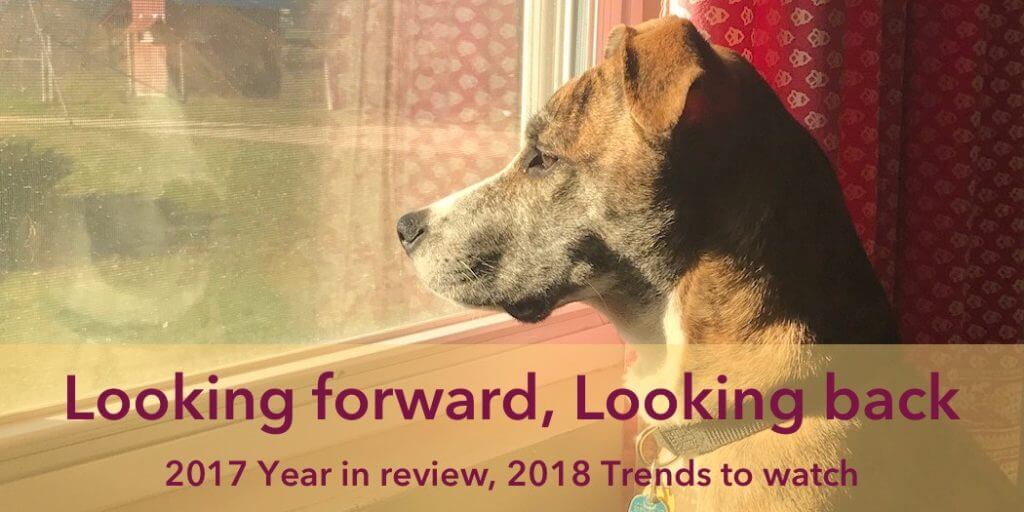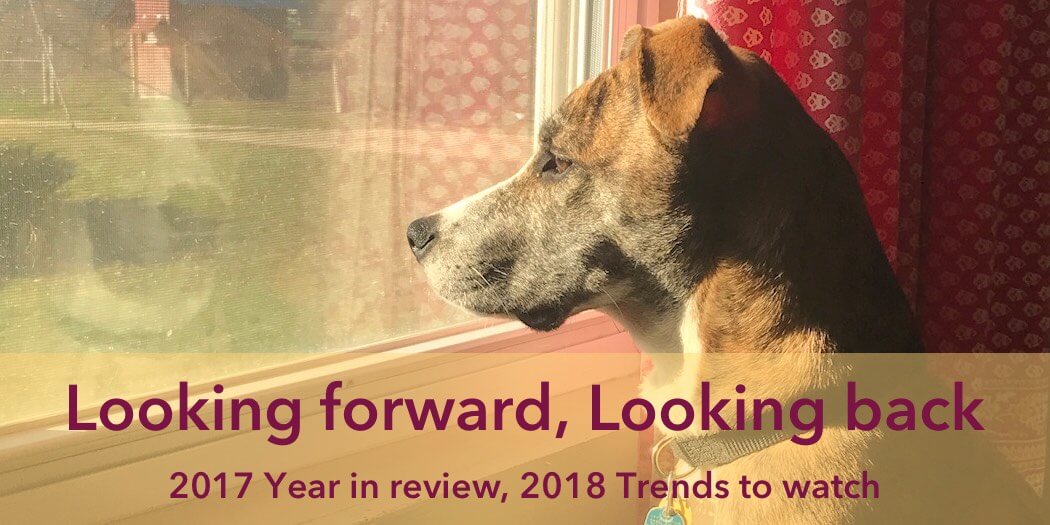Looking back on 2017. Looking forward to 2018.
The turning of the year is, for many of us, a time of reflection. What happened in 2017? What was good? What was not so good? And what do we WANT to happen in 2018? It also just so happens to be the time when most business owners are planning and budgeting. It makes sense to take that exercise a little deeper and to really take stock of a company’s progress and decide on some direction for the following year.
In that spirit of reflection, I’d like to call your attention to 4 trends I saw in 2017, and 5 that I’m tracking for 2018.

2017: AKA, Shooting the rapids.
Although 2017 was a year with lots of political turmoil—both in the US and around the world—legislative uncertainty and near constant scandals (or rumors of scandal) didn’t seem to impede what turned out to be a solid year for most businesses. For some industries there were periods over the past year where decision making slowed; however most of the businesses we’re in touch with are ending the year with solid growth, cash in the bank and positive feelings toward their 2018 goals and budget. This sustained growth has made hiring more difficult to be sure; but isn’t stopping most business owners from feeling good about their business now and in the near future.
With collaboration tools maturing; we now have an embarrassment of riches.
Partially in response to the tightening labor market, many business owners are once again exploring remote employees, or virtual office environments. Many of the collaboration tools have matured to the point where they are truly useful! In fact, the challenge now is which tools to focus on! Dropbox, Google Drive, Slack, Trello, Teamwork, Acuity Scheduling, Calendly, Zoom, UberConference… and then there’s Zapier—to connect them all! With so many (TOO many) choices how do you pick the right one(s) and get everyone on board with it? What do you do when new (or better) tools pop up?
(No, really! How do you do it? Drop me a line if this is something you’re having a hard time with.)
Crowdfunding (Kickstarter, Patreon, etc.) for everyone!
Crowdfunding has been around for a while now, mostly for creative endeavors. Kickstarter has been funding new products and art for the past 8 years, and Patreon has provided ongoing payments to support artists and creators for 4 years. However, more recently crowd funding sites have popped up in a wide range of industries.
There’s Experiment to fund research and Realty Mogul for Real Estate Investing. American Homeowner Preservation is a crowdfund that invests in mortgages. The list goes on.
So maybe your next investor isn’t a person; it’s a crowd. But making that switch isn’t one step to success; there are a lot of “how-tos” and tips for maximizing the benefits of crowdfunding. Of course you’re going to need an extensive mailing list and social following. (You have been working on that, right?) But there’s also an art to getting the momentum going, getting publicity, etc.
Is this something you want to start exploring? (Get a head start NOW—before you need to be good at it!)
Marketing Automation made easy.
Just a few years ago marketing automation meant signing up for a big platform for hundreds of dollars a month. Then came the complicated set-up and uncertain results. Although many of these systems did get terrific results for businesses, they required a lot of smart people to keep them running.
Well I’m here to tell you, times have changed! With just an email delivery system (like MailChimp or Active Campaign), a CRM and some automation tools—(like Zapier)—you can build a pretty credible marketing automation funnel for less than $100/month. Best of all, you don’t need a marketing genius to set it all up.
If you haven’t got started with some kind of email funnel or lead magnet on your website, now is the time! (Give us a call and we can show you what some other folks are doing…)
2018, What’s ahead?
Most economists are forecasting continued growth in 2018. Sure, there are a number of uncertainties: from the situation in North Korea, to the continued crises in the Middle East, to the effect of a new tax code. Still, I’m seeing a lot of small businesses forecasting strong growth for 2018. What’s always true when the economy accelerates is that the talent market gets tighter and we need to work harder to build the team that will work best for our businesses.
We’ve had good years like this before. But one difference I’m seeing this time around is that folks are planning for growth in things beyond sales, like:
Setting a goal to grow your time off!
If you’re a business owner you likely don’t get as much time off as you’d like (and maybe less than your friends in more corporate jobs). This is not good for you—or your team! I recently came across this HBR article from 2009 about a research study where they forced consultants to put down their Blackberries (I told you it was from 2009) and go off-line one day a week. Not only does it show that it can be done but it also describes some rather positive results.
Taking regular, scheduled time off makes taking time off the norm, for you and your team. Doing that builds in healthy adaptations that enable work to progress without you. (Wouldn’t that be great?) And it results in a saner, healthier YOU.
So let go of those excuses and open your calendar right now and put some vacation time down. Try blocking out a two week stretch. If you put it down now it’s way more likely you’ll take it!
Taking more control of your health—mentally and physically.
I see fewer entrepreneurs who are skipping the gym and pulling all nighters. Maybe the message that without your health you can’t build a company or lead anything is finally getting through. (Or maybe I’m just hanging out with healthier people?) But I’m seeing physical health improving among business owners.
But overall “health” is a broader topic; there’s the issue of mental and spiritual health. A lot of folks are noticing that anxiety, and depression seem to be on the rise (though I also suspect that folks are more willing to talk about it than they were in the past). Nevertheless, we need to learn how to better manage our attention and presence to help maintain our mental/spiritual health. I see folks choosing habits over goals and creating calendar rituals that help to keep them in a healthy headspace.
Employment Branding goes mainstream.
The growth in the US economy in 2017 has already increased demand for talented people across the board. And so, if your business depends on young, creative talent, you should realize that the market is extremely limited and salaries are rising fast.
If you are looking for talent in an industry where competition for talent is fierce, you can’t treat “hiring” like an occasional activity. It’s something you need to focus on all the time. Just like you have a pipeline for new business (that you focus on all the time), you need a pipeline for talent (that you focus on all the time). That means building an employer brand for your company.
Just a job posting isn’t enough; you might need to dress it up with some testimonials, social posts, even a video. One small business I know has turned their entire Facebook page and Instagram channel into full-time employment branding. By showing what it’s like to work there, (by highlighting employees and their stories and occasionally talking about their talent needs) they make it easier for employees and partners to recommend a job to their friends.
What are you doing to show (not tell) future employees about how great it is to work in your company—so that when you have openings, people who know you can recommend the best candidates?
Focus is a competitive advantage (talent will be drawn to it as much as clients are).
More focused businesses almost always grow faster than more broadly targeted ones. It’s easier to find your clients if you are looking to help only “Dentists with more than one location”, than if you are trying to help “healthcare professionals”.
This has always been true. The difference is that now we’re seeing Talent recognize it as well. I’m hearing candidates in interviews ask how a firm is different from competitors, how they identify their best clients, and how they measure success with those clients. Top talent is looking for a leadership team that has a plan to win, and is executing on that plan.
One formula for small business success used to be, “Be everywhere, do a little of everything, and see what works.” But trying to be “everywhere” really means you’re not effective at being anywhere (and your employees now know that). Can you clearly articulate your plan to win? Have your employees (and candidates) heard it enough?
What do you see that’s changing from 2017 to 2018? How are you planning for success in the new year?

